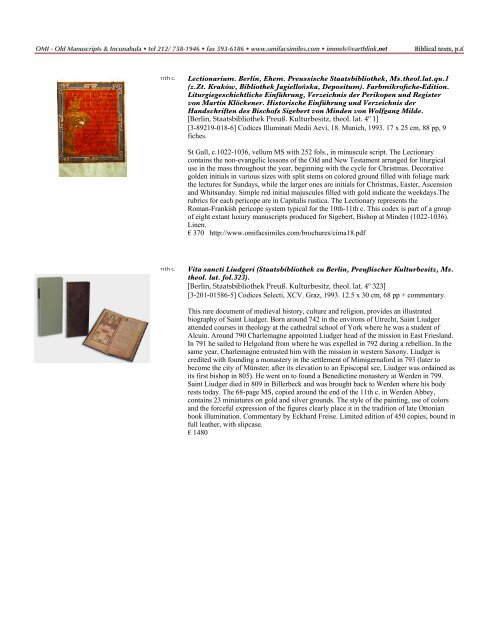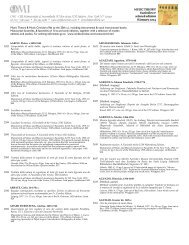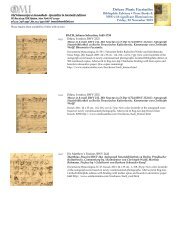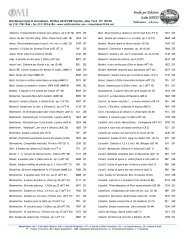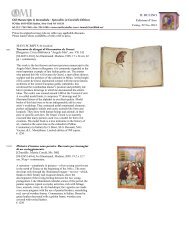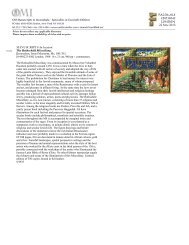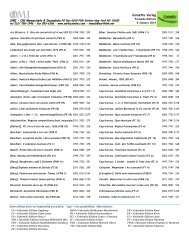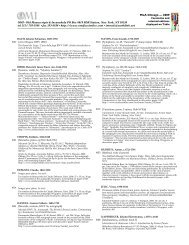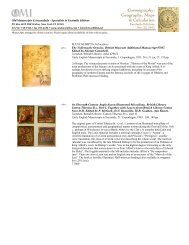Bibles & sacred texts - facsimiles - Omi
Bibles & sacred texts - facsimiles - Omi
Bibles & sacred texts - facsimiles - Omi
You also want an ePaper? Increase the reach of your titles
YUMPU automatically turns print PDFs into web optimized ePapers that Google loves.
OMI - Old Manuscripts & Incunabula • tel 212/ 758-1946 • fax 593-6186 • www.omi<strong>facsimiles</strong>.com • immels@earthlink.net Biblical <strong>texts</strong>, p.6<br />
11th c. Lectionarium. Berlin, Ehem. Preussische Staatsbibliothek, Ms.theol.lat.qu.1<br />
(z.Zt. Kraków, Bibliothek Jagiellońska, Depositum). Farbmikrofiche-Edition.<br />
Liturgiegeschichtliche Einführung, Verzeichnis der Perikopen und Register<br />
von Martin Klöckener. Historische Einführung und Verzeichnis der<br />
Handschriften des Bischofs Sigebert von Minden von Wolfgang Milde.<br />
[Berlin, Staatsbibliothek Preuß. Kulturbesitz, theol. lat. 4º 1]<br />
[3-89219-018-6] Codices Illuminati Medii Aevi, 18. Munich, 1993. 17 x 25 cm, 88 pp, 9<br />
fiches.<br />
St Gall, c.1022-1036, vellum MS with 252 fols., in minuscule script. The Lectionary<br />
contains the non-evangelic lessons of the Old and New Testament arranged for liturgical<br />
use in the mass throughout the year, beginning with the cycle for Christmas. Decorative<br />
golden initials in various sizes with split stems on colored ground filled with foliage mark<br />
the lectures for Sundays, while the larger ones are initials for Christmas, Easter, Ascension<br />
and Whitsunday. Simple red initial majuscules filled with gold indicate the weekdays.The<br />
rubrics for each pericope are in Capitalis rustica. The Lectionary represents the<br />
Roman-Frankish pericope system typical for the 10th-11th c. This codex is part of a group<br />
of eight extant luxury manuscripts produced for Sigebert, Bishop at Minden (1022-1036).<br />
Linen.<br />
€ 370 http://www.omi<strong>facsimiles</strong>.com/brochures/cima18.pdf<br />
11th c. Vita sancti Liudgeri (Staatsbibliothek zu Berlin, Preußischer Kulturbesitz, Ms.<br />
theol. lat. fol.323).<br />
[Berlin, Staatsbibliothek Preuß. Kulturbesitz, theol. lat. 4º 323]<br />
[3-201-01586-5] Codices Selecti, XCV. Graz, 1993. 12.5 x 30 cm, 68 pp + commentary.<br />
This rare document of medieval history, culture and religion, provides an illustrated<br />
biography of Saint Liudger. Born around 742 in the environs of Utrecht, Saint Liudger<br />
attended courses in theology at the cathedral school of York where he was a student of<br />
Alcuin. Around 790 Charlemagne appointed Liudger head of the mission in East Friesland.<br />
In 791 he sailed to Helgoland from where he was expelled in 792 during a rebellion. In the<br />
same year, Charlemagne entrusted him with the mission in western Saxony. Liudger is<br />
credited with founding a monastery in the settlement of Mimigernaford in 793 (later to<br />
become the city of Münster; after its elevation to an Episcopal see, Liudger was ordained as<br />
its first bishop in 805). He went on to found a Benedictine monastery at Werden in 799.<br />
Saint Liudger died in 809 in Billerbeck and was brought back to Werden where his body<br />
rests today. The 68-page MS, copied around the end of the 11th c. in Werden Abbey,<br />
contains 23 miniatures on gold and silver grounds. The style of the painting, use of colors<br />
and the forceful expression of the figures clearly place it in the tradition of late Ottonian<br />
book illumination. Commentary by Eckhard Freise. Limited edition of 450 copies, bound in<br />
full leather, with slipcase.<br />
€ 1480


